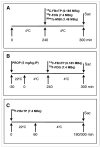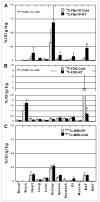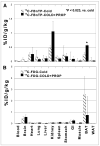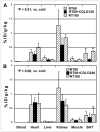18F-fluorobenzyl triphenyl phosphonium: a noninvasive sensor of brown adipose tissue thermogenesis
- PMID: 21498536
- PMCID: PMC4332805
- DOI: 10.2967/jnumed.110.084657
18F-fluorobenzyl triphenyl phosphonium: a noninvasive sensor of brown adipose tissue thermogenesis
Abstract
Recent studies have proposed activation of brown adipose tissue (BAT) thermogenesis as a new strategy to combat obesity. Currently, there is no effective noninvasive imaging agent to directly detect unstimulated BAT and quantify the core mechanism of mitochondrial thermogenesis. We investigated an approach to detect BAT depots and monitor thermogenesis using the mitochondria-targeting voltage sensor radiolabeled fluorobenzyltriphenyl phosphonium (FBnTP).
Methods: (18)F-FBnTP, (14)C-FBnTP, (18)F-FDG, and (99m)Tc-sestamibi uptake in BAT at room temperature (n = 8) and cold-treated (n = 8) Lewis rats was assayed. The effect of the cold condition on (18)F-FBnTP retention in BAT was assessed in 8 treated and 16 control rats. The effect of the noradrenergic inhibitor propranolol on (14)C-FBnTP response to cold stimulation was investigated in an additional 8 treated and 8 control mice.
Results: At room temperature, (18)F-FBnTP accumulated in BAT to an extent similar to that in the heart, second only to the kidney and twice as much as (99m)Tc-sestamibi. Prior exposure to cold (4°C) for 4 h resulted in an 82% decrease of (14)C-FBnTP uptake and an 813% increase of (18)F-FDG uptake in BAT. (99m)Tc-sestamibi uptake was not affected by cold. Administration of (18)F-FBnTP at room temperature 60 min before 120 and 240 min of exposure to cold resulted in marked washout of the tracer from BAT. Propranolol significantly diminished the effect of cold on (14)C-FBnTP and (18)F-FDG uptake into BAT.
Conclusion: The intense uptake of (18)F-FBnTP into BAT at room temperature and the response to cold stimulation suggest the unique potential advantage of (18)F-FBnTP not only in detecting unstimulated BAT at high contrast but also in quantifying the mitochondrial thermogenic activity. (18)F-FBnTP PET may serve as a useful technique to assess BAT volume and function.
Figures




Similar articles
-
Brown Adipose Tissue Response Dynamics: In Vivo Insights with the Voltage Sensor 18F-Fluorobenzyl Triphenyl Phosphonium.PLoS One. 2015 Jun 8;10(6):e0129627. doi: 10.1371/journal.pone.0129627. eCollection 2015. PLoS One. 2015. PMID: 26053485 Free PMC article.
-
Assessment of brown adipose tissue activity in rats by 99mTc-sestamibi uptake.Physiol Res. 2006;55(6):653-659. doi: 10.33549/physiolres.930890. Physiol Res. 2006. PMID: 16497107
-
Loss of UCP2 impairs cold-induced non-shivering thermogenesis by promoting a shift toward glucose utilization in brown adipose tissue.Biochimie. 2017 Mar;134:118-126. doi: 10.1016/j.biochi.2017.01.006. Epub 2017 Jan 24. Biochimie. 2017. PMID: 28130074
-
Origins and early development of the concept that brown adipose tissue thermogenesis is linked to energy balance and obesity.Biochimie. 2017 Mar;134:62-70. doi: 10.1016/j.biochi.2016.09.007. Epub 2016 Sep 10. Biochimie. 2017. PMID: 27621146 Review.
-
Near-Infrared Time-Resolved Spectroscopy for Assessing Brown Adipose Tissue Density in Humans: A Review.Front Endocrinol (Lausanne). 2020 May 19;11:261. doi: 10.3389/fendo.2020.00261. eCollection 2020. Front Endocrinol (Lausanne). 2020. PMID: 32508746 Free PMC article. Review.
Cited by
-
Radiolabeled Phosphonium Salts as Mitochondrial Voltage Sensors for Positron Emission Tomography Myocardial Imaging Agents.Nucl Med Mol Imaging. 2016 Sep;50(3):185-95. doi: 10.1007/s13139-016-0397-x. Epub 2016 Feb 29. Nucl Med Mol Imaging. 2016. PMID: 27540422 Free PMC article. Review.
-
Imaging of Brown Adipose Tissue: State of the Art.Radiology. 2016 Jul;280(1):4-19. doi: 10.1148/radiol.2016150390. Radiology. 2016. PMID: 27322970 Free PMC article. Review.
-
Quantification of human and rodent brown adipose tissue function using 99mTc-methoxyisobutylisonitrile SPECT/CT and 18F-FDG PET/CT.J Nucl Med. 2013 Nov;54(11):1896-901. doi: 10.2967/jnumed.113.121012. Epub 2013 Sep 26. J Nucl Med. 2013. PMID: 24071505 Free PMC article.
-
An Automated Multidose Synthesis of the Potentiometric PET Probe 4-[18F]Fluorobenzyl-Triphenylphosphonium ([18F]FBnTP).Mol Imaging Biol. 2018 Apr;20(2):205-212. doi: 10.1007/s11307-017-1119-1. Mol Imaging Biol. 2018. PMID: 28905308 Free PMC article.
-
Imaging adipose tissue browning using the TSPO-18kDa tracer [18F]FEPPA.Mol Metab. 2019 Jul;25:154-158. doi: 10.1016/j.molmet.2019.05.003. Epub 2019 May 6. Mol Metab. 2019. PMID: 31105057 Free PMC article.
References
-
- Smyth S, Heron A. Diabetes and obesity: the twin epidemics. Nat Med. 2006;12:75–80. - PubMed
-
- Cao Y. Adipose tissue angiogenesis as a therapeutic target for obesity and metabolic diseases. Nat Rev Drug Discov. 2010;9:107–115. - PubMed
-
- Bray GA. Drug insight: appetite suppressants. Nat Clin Pract Gastroenterol Hepatol. 2005;2:89–95. - PubMed
-
- Ioannides-Demos LL, Proietto J, Tonkin AM, McNeil JJ. Safety of drug therapies used for weight loss and treatment of obesity. Drug Saf. 2006;29:277–302. - PubMed
Publication types
MeSH terms
Substances
Grants and funding
LinkOut - more resources
Full Text Sources
Other Literature Sources
